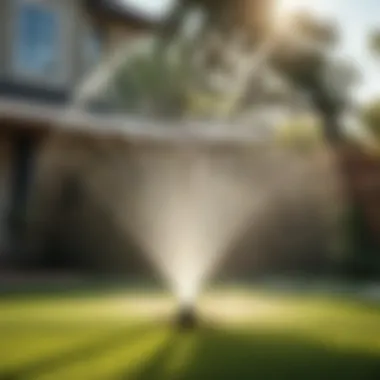Materials:
- Grass seeds: 5 lbs of Kentucky Bluegrass, 2 lbs of Bermuda grass, and 3 lbs of Fescue grass
- Soil conditioner: 10 bags of organic compost
- Fertilizer: 1 bag of slow-release nitrogen-rich fertilizer
- Sprinkler system: Oscillating sprinkler with adjustable width and range features
- Gardening gloves
- Shovel
- Rake
- Wheelbarrow
DIY Steps:
To begin, prepare the soil by aerating it with a shovel to allow for better water penetration. Next, spread a thin layer of compost evenly over the lawn area. After that, mix the grass seeds together and spread them over the soil. Water the lawn lightly to help the seeds settle. Wait for a week before applying the fertilizer to promote healthy growth.
Technical Aspects:
It is crucial to choose the right type and amount of grass seeds for your lawn, based on sunlight exposure and soil type. The soil conditioner aids in improving soil structure and providing essential nutrients. Proper watering techniques are essential for successful lawn establishment. The sprinkler system should be adjusted according to the lawn size and water requirements.
DIY Project Process:


Once the seeds have germinated, continue to water the lawn regularly, ensuring the soil stays moist but not waterlogged. Monitor the growth progress and adjust the sprinkler system settings as needed. To troubleshoot dry patches, increase watering frequency. For overwatering issues, allow the soil to dry out slightly between watering sessions.
Introduction


In the realm of lawn care and maintenance, having a well-crafted understanding of the core principles is paramount for ensuring a verdant and thriving outdoor space. This introductory section of our comprehensive guide serves as the gateway to a wealth of knowledge and practical insights that will empower housewives and homeowners alike to elevate their lawn care practices to exemplary levels. By delving into the nuances of grass types, climate considerations, mowing techniques, and the crucial role of sprinkler systems, readers will embark on a journey towards achieving a lush and healthy lawn that is the envy of the neighborhood.
Grass types play a pivotal role in determining the aesthetic appeal and resilience of a lawn. From the resilient Kentucky Bluegrass to the drought-tolerant Bermuda Grass and the luxurious Zoysia Grass, understanding the characteristics of each grass type will equip readers with the knowledge needed to make informed decisions when planning their lawn care regimen. Furthermore, considerations such as adapting to different climates and embracing sustainable practices underscore the importance of tailoring lawn care efforts to specific environmental conditions, optimizing growth and vitality.
Transitioning into the practical aspects of lawn care, mowing techniques emerge as a critical component. By learning the proper height adjustment for grass blades and the ideal frequency of mowing, individuals can promote healthy growth, prevent thatch buildup, and achieve a neat and attractive lawn appearance. Complementing mowing practices, fertilization emerges as a key step in nourishing the soil and providing essential nutrients to support vigorous grass growth. Exploring various types of fertilizers and application tips will enable readers to cultivate a nutrient-rich environment conducive to the flourishing of their lawn.
As the discussion shifts towards the indispensable role of watering in maintaining a green oasis, the benefits of a well-designed sprinkler system come to the forefront. The efficiency of water distribution and the customization options afforded by modern sprinkler technology ensure that every corner of the lawn receives adequate hydration, promoting uniform growth and vitality. By optimizing the placement of sprinklers and fine-tuning irrigation settings for water conservation, readers can strike a balance between lushness and environmental responsibility, ushering in a new era of sustainable lawn care practices.
In essence, this introduction sets the stage for a deep dive into the intricacies of lawn care and sprinkler systems, offering a roadmap for realizing a verdant and vibrant outdoor space that brings joy and pride to homeowners.
Understanding Your Lawn


In this article, understanding your lawn is the cornerstone of achieving a lush and healthy outdoor space. By delving into the specifics of your lawn, you can tailor care practices to suit its unique needs, ultimately culminating in a vibrant and thriving landscape. Understanding your lawn entails grasping essential elements such as grass types and climate considerations, which form the basis for effective maintenance strategies.
Grass Types
Kentucky Bluegrass
Kentucky Bluegrass is renowned for its lush, emerald-green appearance and fine texture, making it a popular choice for lawns seeking a pristine aesthetic. Its high tolerance for foot traffic and excellent self-repair capabilities contribute to its appeal for homeowners seeking a resilient grass type. Additionally, Kentucky Bluegrass thrives in cooler climates and requires moderate maintenance, ideal for those looking for a pristine lawn with manageable care requirements.
Bermuda Grass
Bermuda Grass is a warm-season grass known for its excellent heat tolerance and rapid growth rate. With its ability to establish quickly and withstand heavy foot traffic, Bermuda Grass is often favored for high-activity areas in the lawn. Its exceptional drought resistance and vibrant green color make it an attractive choice, particularly in regions with hot summers where water conservation is vital.
Zoysia Grass
Zoysia Grass stands out for its dense growth pattern, providing a lush carpet-like appearance when properly maintained. Its tolerance for varying light conditions and minimal mowing requirements make it a low-maintenance yet visually appealing option for lawns. Zoysia Grass thrives in warm climates but can also adapt to cooler regions with proper care, offering homeowners versatility in their landscaping choices.
Climate Considerations
Adapting to Different Climates
Adapting to different climates involves selecting grass types that can withstand the specific environmental conditions prevalent in your region. By choosing grass varieties suited to the local climate, homeowners can ensure long-term lawn health and vitality. Factors such as temperature fluctuations, rainfall levels, and sunlight exposure must be considered when choosing grass species, emphasizing the need for adaptability to ensure a thriving lawn year-round.
Sustainable Practices
Sustainable lawn care practices prioritize environmental stewardship while maintaining a beautiful lawn. By implementing sustainable practices like water conservation, natural fertilization methods, and integrated pest management, homeowners can reduce their carbon footprint and promote biodiversity in their outdoor spaces. Embracing sustainable practices not only benefits the environment but also enhances the long-term health and resilience of the lawn, creating a harmonious balance between aesthetics and eco-consciousness.
Lawn Care Basics
Lawn care basics are the foundation of maintaining a vibrant and healthy lawn, serving as the cornerstone of this comprehensive guide to lawn care and sprinkler systems. Understanding the essential components of proper lawn care is crucial for achieving a lush, green lawn that enhances the overall aesthetics of your property. By delving into topics such as mowing techniques, fertilization, and watering strategies, this section provides invaluable insights into nurturing your lawn to its full potential.
Mowing Techniques
Proper Height Adjustment
Proper height adjustment is a critical aspect of mowing techniques that significantly impacts the health and appearance of your lawn. Setting the mower at the correct height ensures that grass is trimmed to an optimal level, promoting healthy growth and preventing damage. Maintaining a consistent cutting height based on the type of grass in your lawn is essential for a uniform look and enhances the overall resilience of the grass. Proper height adjustment allows for adequate photosynthesis, root development, and helps in combating weed growth, making it a fundamental practice for effective lawn care.
Frequency of Mowing
The frequency of mowing plays a pivotal role in maintaining the health and lushness of your lawn. Regular mowing helps in controlling weed growth, preventing the grass from becoming stressed, and promoting a well-manicured appearance. By adhering to a proper mowing schedule based on the growth rate of your grass, you can ensure that the lawn remains at an ideal length for optimal health. However, it is essential to avoid over-mowing, as cutting the grass too short can weaken it and make it more susceptible to stressors like pests and diseases. Balancing the frequency of mowing with the growth patterns of your grass is key to promoting a thriving lawn.
Fertilization
Fertilization is a vital component of lawn care that provides essential nutrients to support the growth and vitality of your grass. Understanding the different types of fertilizers available and their specific benefits is crucial for creating a targeted fertilization plan that meets the needs of your lawn. Selecting the right fertilizer based on the nutrient requirements of your grass can enhance root development, improve resilience to environmental stressors, and promote vibrant greenery. Additionally, proper application tips, such as using the correct spreader settings and applying fertilizer at the recommended times, are essential for maximizing the effectiveness of fertilization while minimizing potential risks like nutrient runoff. By incorporating a strategic fertilization regimen into your lawn care routine, you can achieve a luxuriant and healthy lawn that will be the envy of your neighborhood.
Watering Your Lawn
Watering your lawn is a crucial aspect of lawn care that significantly impacts the health and vibrancy of your grass. In this comprehensive guide to lawn care and sprinkler systems, understanding the importance of proper watering techniques is paramount. Efficient watering practices not only ensure the lush green appearance of your lawn but also contribute to its overall well-being. By exploring the benefits and considerations of watering your lawn, you can create a thriving outdoor space.
Benefits of a Sprinkler System
Efficient Water Distribution
Efficient water distribution is a key feature of a sprinkler system that plays a vital role in maintaining a healthy lawn. The unique characteristic of efficient water distribution lies in its ability to evenly water a large area, ensuring that every inch of your lawn receives the necessary moisture. This method is beneficial as it helps prevent under or overwatering, promoting uniform growth and minimizing water wastage. The advantages of efficient water distribution in this guide focus on optimizing water usage and promoting the health of your grass.
Customization Options
Customization options provided by sprinkler systems offer flexibility and precision in watering your lawn. The key characteristic of customization options is their adaptability to different lawn sizes, shapes, and water requirements. This feature allows homeowners to tailor their watering schedules based on specific needs, leading to better water conservation practices and improved lawn health. By detailing the unique features and advantages of customization options, this guide emphasizes the importance of personalized irrigation solutions for achieving a lush and sustainable lawn.
Optimizing Your Sprinkler System
Proper Placement of Sprinklers
Proper placement of sprinklers is essential for maximizing the effectiveness of your sprinkler system. The key characteristic of correct sprinkler placement lies in ensuring even coverage and avoiding water runoff or dry spots. By strategically placing sprinklers based on the layout of your lawn and the water distribution needs, you can achieve uniform watering and promote healthy grass growth. This section highlights the unique benefits of proper sprinkler placement in this guide, emphasizing the role it plays in maintaining a lush and well-nourished lawn.
Adjusting for Water Conservation
Adjusting your sprinkler system for water conservation is a responsible practice that promotes sustainability. The key characteristic of water conservation adjustments is their capacity to minimize water usage while still meeting the lawn's watering needs. By fine-tuning the sprinkler system settings based on factors such as soil type, weather conditions, and plant requirements, homeowners can reduce water wastage and contribute to environmental conservation efforts. This guide elaborates on the advantages and disadvantages of adjusting for water conservation, highlighting the importance of adopting efficient watering practices for a healthy and eco-friendly lawn.
Dealing with Common Lawn Issues
In the realm of lawn care and maintenance, addressing common lawn issues holds significant importance due to its crucial role in ensuring the health and aesthetics of your lawn. By focusing on key elements such as weed control and pest management, you can proactively tackle issues that may hinder your lawn's beauty and vitality. Dealing with Common Lawn Issues is a pivotal section in this comprehensive guide as it equips housewives and homeowners with the necessary knowledge and strategies to overcome challenges and nurture a thriving lawn environment.
Weed Control
Pre-Emergent Herbicides
Delving into the specifics of Pre-Emergent Herbicides reveals their essential contribution to weed control within the realm of lawn care. These herbicides possess a key characteristic of preventing weed germination before it occurs, making them a popular choice for individuals looking to maintain a lush lawn. The unique feature of Pre-Emergent Herbicides lies in their proactive approach, providing long-lasting protection against weeds. While they offer effective weed prevention, it's important to consider their disadvantages, such as potential harm to beneficial plants.
Organic Weed Control Methods
Exploring Organic Weed Control Methods sheds light on their positive impact on maintaining a natural and healthy lawn. The key characteristic of these methods is their environmentally friendly nature, making them a beneficial choice for those seeking organic lawn care solutions. The unique feature of Organic Weed Control Methods lies in their ability to target weeds without introducing harmful chemicals into the ecosystem. Despite their advantages in promoting ecological balance, some may find organic methods require more frequent application compared to synthetic alternatives.
Pest Management
Identifying Common Pests
Discussing the identification of common pests is integral to effective pest management in the context of lawn care. Recognizing key characteristics of pests allows homeowners to address infestations promptly, promoting a pest-free lawn environment. The unique feature of identifying common pests is the ability to implement targeted control measures tailored to specific pest species, minimizing damage to the lawn. While advantageous in early intervention, misidentification of pests can lead to ineffective treatment outcomes.
Integrated Pest Management
Exploring Integrated Pest Management underscores its holistic approach to pest control, offering a comprehensive solution for maintaining a pest-resistant lawn. The key characteristic of this method lies in its emphasis on utilizing multiple strategies, such as biological controls and cultural practices, to deter pests effectively. The unique feature of Integrated Pest Management is its sustainable and environmentally conscious nature, promoting long-term pest control without relying heavily on chemical interventions. However, a potential disadvantage may include the necessity of consistent monitoring to assess the effectiveness of integrated approaches.





